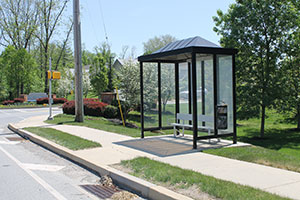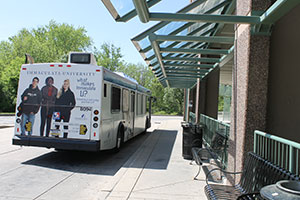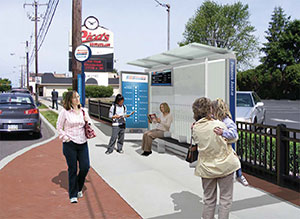Bus Stops
Bus Stop
A designated location - typically along a fixed bus route - where people gather to board and/or exit a bus.
The quality of a public transit ride is defined by all aspects of a rider's experience, from the time of departure to arrival at the destination. Beyond a rider's experience in the transit vehicle, there are two additional significant components to a "full" transit ride: the connection between a transit stop and one's origin/destination; and the experience waiting for the arrival of the transit vehicle. In this context, the provision of bus stop amenities such as a bus shelter and sidewalk connections have influential roles regarding the quality of public transit in Chester County.
"A high-quality transit stop is one that is well connected to the neighborhood or community it serves, accommodates the needs of all transit passengers safely and comfortably, and permits efficient and cost-effective transit operations." — SEPTA Bus Stop Design Guidelines
Bus stops are located along the bus routes in the urban and suburban municipalities served by public transit. The primary service provider in Chester County is SEPTA, although additional bus routes are provided by the Transportation Management Association of Chester County (TMACC) including the Coatesville Link and SCCOOT (a partnership with the Southern Chester County Organization on Transportation); Krapf Transit Route A that connects Coatesville, Exton and West Chester; and the Pottstown Area Rapid Transit (PART) which provides bus service to the Coventry Mall and North Coventry Township emanating from Pottstown Borough.
 This design element focuses on the development of bus stops, including bus shelters as amenities and the possible configurations for stop locations in line with the roadway.
This design element focuses on the development of bus stops, including bus shelters as amenities and the possible configurations for stop locations in line with the roadway.
Location
Proper site selection is critical for creating a safe and efficient bus stop. When planning for new or upgrading existing transit stops, municipal officials should reference the SEPTA Bus Stop Design Guidelines, prepared for SEPTA by the Delaware Valley Regional Planning Commission (DVRPC) in October 2012. These guidelines would also apply to areas served by other transit operators.
Bus stops may be placed in one of three general locations relative to the roadway and intersections:

- Far-side stop
- Near-side stop; and,
- Midblock stop.
Placement at one of these three locations within the roadway must also consider in-street design alternatives relative to the flow of traffic. The SEPTA guidelines include guidance for the following in-street design alternatives illustrated below:
- Curbside/Shoulder Stop
- Curb Extension
- Bus Bay/Turnout
- Open Bus Bay

Bus stops located outside of the roadway path are considered to be "off-line" stops and are commonly associated with transportation centers, railroad stations, office or medical centers, shopping centers, or park-and-ride facilities.
The SEPTA Bus Stop Design Guidelines also provide guidance towards the recommended dimensions for the standard elements of a bus stop in the chapter titled 'Curbside Design'. These elements include a loading pad, waiting area, stop area, pedestrian path, street furniture (if applicable), and a clear area for the following six bus stop types:
- Minimum stop with recessed pedestrian path;
- Minimum stop with curbside pedestrian path;
- Narrow urban stop;
- Urban stop with seating;
- Stop with narrow shelter; and,
- Stop with standard shelter.
Developers should determine which configuration and stop type may be most applicable to the proposed bus stop location based on existing roadway characteristics and site conditions, and refer to the SEPTA Bus Stop Design Guidelines for the most applicable guidelines towards its design. SEPTA staff can serve as a resource for site specific issues along its routes. The Service Planning Department can be reached at 215-580-7978 or serviceplanning@septa.org.
For additional stop types in a suburban setting, another point of reference to consider would be the Rethinking the Suburban Bus Stop and Safety & Security at Suburban Bus Stops publications prepared by the Airport Corridor Transportation Association (ACTA) in western Pennsylvania.
Bus Shelter
A transit user amenity located at a bus stop to provide convenience, comfort, and shelter from the elements in the form of a structure such as a canopy.
Bus shelters can greatly improve the public transportation experience by providing riders with a safe waiting area, protection during inclement weather, and service information. Bus shelters are generally located in a roadway right-of-way unless private property owners have consented to the shelter being placed on their property. Shelters can be integrated into the building design, as shown in the Exton Mall image below, where a bus stop and shelter was implemented as part of the Mall's renovation several years ago.


Municipalities should adopt requirements for the placement of bus stops with shelters in municipal ordinances when buildings, uses, or developments, that meet a minimum threshold, and occur along or within proximity of an existing or planned bus route. Pedestrian connections to the bus stop/transit shelter from parking lots and nearby development should be required as referenced in the SEPTA Bus Stop Design Guidelines which recommends a pedestrian way connecting to every stop. Each municipality will need to determine the appropriate criteria for what type of development (size, number of units, density) should trigger the requirement for a bus stop with shelter. Each municipality should also determine criteria for maintenance and operational responsibilities for shelters.
Implementation of pedestrian connections and bus shelters will rely heavily upon the local land development process as well as targeted capital improvement projects at key locations where land development may not be imminent or where these facilities are identified to be most needed.
To direct improvements where they are most needed, the Public Transportation Plan recommends bus shelters at bus stops with greater than 5 daily boardings.

The 'Bus stops recommended for shelters in Chester County' exhibit above was generated based on the bus ridership data (daily boards) available at the time of the study. As the ridership continues to grow and evolve with varied degree of intensity, those ridership numbers will change. CCPC recommends the following three classifications of bus stops relative to the minimum curbside amenities to be provided at bus stops based on actual ridership data:
Basic Stop: daily boards of 5 or less

- Bus Stop sign printed on both sides to be visible from the roadway;
- ADA accessible loading pad; and
- Paved pedestrian sidewalk/walkway connections (ADA accessible) leading to the nearest building entrance or connecting to an existing walkway system.
Collector Stop: daily boards from 6-20

Includes all Basic Stop amenities plus:
- Bus Shelter;
- System map indicating all transit routes serving the location;
- Bench and Trash Receptacle; and
- Lighting
Hub Stop: daily boards from 21-50

Includes all Collector Stop amenities plus:
- Bus Shelters (minimum of 1, or a larger sized shelter);
- Benches and Trash Receptacles (minimum of 2 each);
- Bicycle Racks; and
- Real time status info/kiosk
Daily boards greater than 50:

The following are photo simulations illustrating how an existing bus stop may be developed using the SEPTA Bus Stop Design Guidelines. Site 1 is an example of a far-side stop with a bus bay/turnout, and site 2 is an example of another far-side stop with a curbside/shoulder boarding configuration.

Collector and Hub stops may be placed off-line (outside the roadway) and within a site development to accommodate for the additional time required to load and unload what would be a higher volume of passengers and minimize any associated traffic impacts. These stops would be most applicable to commercial and employment centers and should be provided in a central location relative to all sites that may be served and connected by pedestrian walkways.
Bus stop installations must consider both inbound/outbound directions for the associated transit route(s). Stops may be needed on either side of the roadway or intersection to provide for access to each direction.
An existing barrier to bus stop development is the reluctance of various agencies to assume the maintenance responsibilities of bus shelters. Many existing shelters are provided and maintained by advertising agencies that at the present time have no interest in expanding their footprint in Chester County.
Transit agencies are not responsible for the design or maintenance of transit stops in Chester County. Therefore, the provision of high-quality transit stops requires a partnership between transit agencies, Transportation Management Associations, municipalities, PennDOT, and property owners.
Recommendations
- Provide the recommended curbside amenities as per the Basic, Collector, and Hub stop classifications described herein based on the projected ridership (daily boards) associated with the proposed new development for new bus stop installations.
- Retrofit existing bus stops to provide for the curbside amenities as per the Basic, Collector, and Hub stop classifications described herein based on historically consistent existing actual ridership (daily boards).
- Follow the recommendations of the SEPTA Bus Stop Design Guidelines towards the design and implementation of new and/or retrofit bus stop development.
- Provide bus shelters and pathways to and from transit shelters as part of high density land uses and major traffic generators near existing or future transit routes. Prioritizing the installation of these basic amenities at the more frequently used stops will create a safe and inviting point of access to the transit system and serve as an example for the implementation of improvements at other stop locations. Bus stop consolidation may be used to provide for more boardings at certain locations which would also contribute to increased route efficiency. Local ordinances may also need to be adjusted or revisited to allow for the placement of bus shelters, depending on the existing statutes.
- Consider including requirements for bus stops in zoning and/or subdivision/land development ordinances. The following are recommended guidelines towards the establishment of a bus stop with shelter ordinance:
- Bus stops with shelters should be required along existing public transportation routes or key transportation corridors that have the potential for public transit service based on the density or intensity of proposed residential, institutional, commercial, or industrial uses. For example, a bus stop with shelter should be required where the gross leasable area for commercial, industrial, or institutional uses is fifty-thousand (50,000) square feet or more or where there is a residential development greater than one hundred (100) dwellings units. The municipality can adjust the "thresholds" to meet their community objectives or the intent of the associated zoning district.
- Bus stops with or without shelters should be adequately lighted to provide safety and visibility for users. The source of light shall be shielded from all abutting properties and from traffic along any adjacent roadway.
- Sidewalks and internal walkways should be provided to connect bus stops shelters to adjacent uses that generate significant pedestrian traffic.
- Bus stops with shelters and their related facilities and amenities should be designed in accordance with the design standards of the SEPTA Bus Stop Design Guidelines as produced by the Delaware Valley Regional Planning Commission (DVRPC). Where there are site-specific issues that are not explicitly covered by the SEPTA Bus Stop Design Guidelines, it is particularly important that they be vetted by the operating agency. This includes situations where a design exception or mitigation of conditions is required. In the case of SEPTA, both Service Planning and Transportation (operations) should be consulted to insure that there are no unintended operational issues that are generated by the bus stop design .
- The municipality shall have the final determination as to the location of bus stops with shelters. Area and bulk regulations of the associated zoning district shall not apply to the placement of bus stops with shelters.
- Bus shelters shall be placed on a concrete slab which should be constructed in accordance with municipal ordinances.
- Bus shelters should not exceed five (5) feet in width and ten (10) in length and shall be constructed of an aluminum frame with a minimum of two (2) sides enclosed with lexan, acrylic, Plexiglas, or safety glass and a roof. A bench should be provided in the shelter with a center divider/arm rest and a trash receptacle in a style approved by the municipality.
- Bus stops with shelters should be well-marked/identified with a double-sided sign, preferably on its own pole in accordance with current SEPTA sign standards.
- Bus stops with shelters should be maintained in a clean and neat condition and in good working order and repair and shall be inspected and cleaned at least once every seven (7) days.
- Develop a maintenance agreement model(s) for maintaining bus shelter facilities. Given that bus shelter maintenance is one of the existing barriers to implementing additional bus shelters in retrofit contexts, the public transportation agency providers, the TMAs, chambers of commerce, municipalities, and Chester County must identify at least one (preferably multiple) model for maintaining bus shelters that is agreeable and endorsed by all aforementioned parties. In the context of future land development projects, the maintenance of bus shelters should be codified as an obligation of the land developer/property owner.
| Amenities | |||||||||
|---|---|---|---|---|---|---|---|---|---|
| Stop Type | Bus Stop Sign | ADA Loading Pad | Paved Walkway Connections | Bus Shelter | System Map | Bench / Trash Can | Lighting | Bike Racks | Real Time Info |
| Basic Stop (daily boards of 5 or less) | X | X | X | ||||||
| Collector Stop (daily boards from 6 to 20) | X | X | X | X | X | X | X | ||
| Hub Stop (daily boards from 21 to 50) | X | X | X | X* | X | X** | X | X | X |
*Minimum of 1, or larger sized shelters.
**Minimum of 2 each.
References
- Public Transportation Plan
- SEPTA Bus Stop Design Guidelines
- Safety & Security at Suburban Bus Stops
- Rethinking the Suburban Bus Stop
- APTA's Design of On-street Transit Stops and Access from Surrounding Areas


